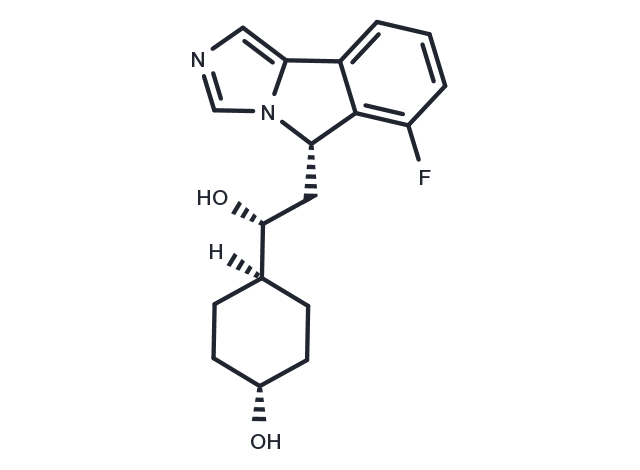Powder: -20°C for 3 years | In solvent: -80°C for 1 year


Navoximod (GDC-0919) (NLG- 919, GDC-0919) is a potent indoleamine-(2,3)-dioxygenase (IDO) pathway inhibitor (Ki/EC50: 7 nM/75 nM).

| Pack Size | Availability | Price/USD | Quantity |
|---|---|---|---|
| 1 mg | In stock | $ 162.00 | |
| 5 mg | In stock | $ 347.00 | |
| 10 mg | In stock | $ 522.00 | |
| 25 mg | In stock | $ 667.00 | |
| 50 mg | In stock | $ 828.00 | |
| 100 mg | In stock | $ 1,160.00 | |
| 1 mL * 10 mM (in DMSO) | In stock | $ 353.00 |


| Description | Navoximod (GDC-0919) (NLG- 919, GDC-0919) is a potent indoleamine-(2,3)-dioxygenase (IDO) pathway inhibitor (Ki/EC50: 7 nM/75 nM). |
| Targets&IC50 | IDO:7 nM (Ki), IDO:75 nM (EC50) |
| In vitro | Using IDO-expressing human monocyte-derived dendritic cells (DCs) in allogeneic mixed lymphocyte reaction (MLR) reactions, Navoximod potently blocks IDO-induced T cell suppression and restores robust T cell responses (ED50: 80 nM). Similarly, using IDO-expressing mouse DCs from tumor-draining lymph nodes, Navoximod abrogates IDO-induced suppression of antigen-specific T cells (OT-I) in vitro (ED50: 120 nM) [1]. Navoximod inhibits the IDO activity in a concentration-dependent manner with an EC50 of 0.95?μM. PEG2k-Fmoc-NLG(L) is less active (EC50: 3.4?μM) in inhibiting IDO compared with free Navoximod while PEG2k-Fmoc-NLG(S) is least active (EC50>10?μM). Coculture of IDO+tumor cells with splenocytes isolated from BALB/c mice leads to significant inhibition of T-cell proliferation. This inhibition is significantly attenuated when the mixed cells are treated with Navoximod. PEG2k-Fmoc-NLG(L) is also active in reversing the inhibitory effect of tumor cells although slightly less potent than Navoximod [3]. |
| In vivo | In mice, a single oral administration of Navoximod reduces the concentration of plasma and tissue Kyn by ~50%. In vivo, in mice bearing large established B16F10 tumors, administration of Navoximod markedly enhances the anti-tumor responses of na?ve, resting pmel-1 cells to vaccination with cognate hgp100 peptide plus CpG-1826 in IFA. In this stringent established-tumor model, Navoximod plus pmel-1/vaccine produces a dramatic collapse of tumor size within 4 days of vaccination (~95% reduction in tumor volume compared to control animals receiving pmel-1/vaccine alone without Navoximod) [1]. When combined with Temozolomide (TMZ)+radiation therapy (RT), both Navoximod and 1-methyl-D-tryptophan (D-1MT, indoximod) enhance survival relative to mice treated with TMZ+RT alone [2]. |
| Cell Research | Briefly, HeLa cells are seeded in a 96-well plate at a cell density of 5000 cells per well and allowed to grow overnight. Recombinant human IFN-γ is then added to each well with a final concentration of 50?ng/mL. At the same time, various concentrations of PEG2k-Fmoc-NLG(L), PEG2k-Fmoc-NLG(S) or Navoximod (NLG919) (50?nM-20?μM) are added to the cells. After 48?h of incubation, 150?μL of the supernatants per well is transferred to a new 96-well plate. Seventy-five μL of 30% trichloroacetic acid is added into each well and the mixture is incubated at 50°C for 30?min to hydrolyse N-formylkynurenine to kynurenine. For the colorimetric assay, supernatants are transferred to a new 96-well plate, mixed with an equal volume of Ehrlich reagent (2% p-dimethylamino-benzaldehyde w/v in glacial acetic acid), and incubated for 10?min at RT. The reaction product is measured at 490?nm by a plate reader [3]. |
| Animal Research | Mice are anesthetized with 4% isoflurane, and the surgical plane of anesthesia is maintained with 2% isoflurane in oxygen. Mice are immobilized in a stereotactic frame for tumor implantation. Briefly, the skull is shaved and exposed with a 0.5 cm skin incision. With the antiseptic technique, 10^5 GL261 cells (suspended in 3 μL RPMI-1640) are injected at the following coordinates with respect to the bregma on the right side (antero-posterior, -2 mm; medio-lateral, 2 mm; dorsoventral, 3 mm). This placement reproducibly yielded tumor growth in a paracortical area of the posterolateral right frontal lobe. Tumor-bearing mice are treated with combinations of oral DL-1MT (2 mg/mL D-1MT mixed with 2 mg/mL L-1MT) in drinking water, D-1MT (4 mg/mL) in drinking water, Navoximod (6 mg/mL) in drinking water, intraperitoneal cyclophosphamide, intraperitoneal temozolomide, and/or total-body radiation (500 cGy from a 137Cs source), as detailed in figure legends. Mice are observed daily and sacrificed when they became ill or moribund [2]. |
| Synonyms | GDC-0919, NLG-919 |
| Molecular Weight | 316.37 |
| Formula | C18H21FN2O2 |
| CAS No. | 1402837-78-8 |
Powder: -20°C for 3 years | In solvent: -80°C for 1 year
DMSO: 100 mg/mL (316.09 mM), Sonification is recommended.
You can also refer to dose conversion for different animals. More
bottom
Please see Inhibitor Handling Instructions for more frequently ask questions. Topics include: how to prepare stock solutions, how to store products, and cautions on cell-based assays & animal experiments, etc.
Navoximod 1402837-78-8 Metabolism Indoleamine 2,3-Dioxygenase (IDO) GDC0919 inhibit Inhibitor NLG-?919 NLG 919 GDC-0919 NLG-919 NLG919 NLG-919 GDC 0919 inhibitor
